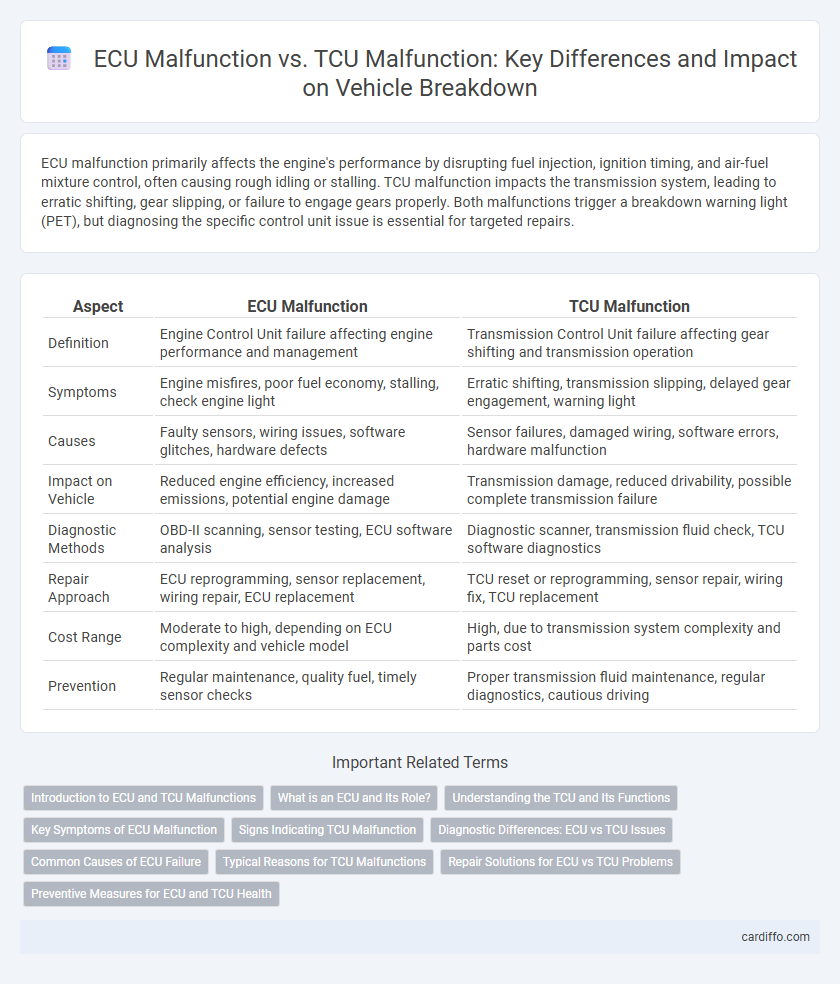ECU malfunction primarily affects the engine's performance by disrupting fuel injection, ignition timing, and air-fuel mixture control, often causing rough idling or stalling. TCU malfunction impacts the transmission system, leading to erratic shifting, gear slipping, or failure to engage gears properly. Both malfunctions trigger a breakdown warning light (PET), but diagnosing the specific control unit issue is essential for targeted repairs.
Table of Comparison
| Aspect | ECU Malfunction | TCU Malfunction |
|---|---|---|
| Definition | Engine Control Unit failure affecting engine performance and management | Transmission Control Unit failure affecting gear shifting and transmission operation |
| Symptoms | Engine misfires, poor fuel economy, stalling, check engine light | Erratic shifting, transmission slipping, delayed gear engagement, warning light |
| Causes | Faulty sensors, wiring issues, software glitches, hardware defects | Sensor failures, damaged wiring, software errors, hardware malfunction |
| Impact on Vehicle | Reduced engine efficiency, increased emissions, potential engine damage | Transmission damage, reduced drivability, possible complete transmission failure |
| Diagnostic Methods | OBD-II scanning, sensor testing, ECU software analysis | Diagnostic scanner, transmission fluid check, TCU software diagnostics |
| Repair Approach | ECU reprogramming, sensor replacement, wiring repair, ECU replacement | TCU reset or reprogramming, sensor repair, wiring fix, TCU replacement |
| Cost Range | Moderate to high, depending on ECU complexity and vehicle model | High, due to transmission system complexity and parts cost |
| Prevention | Regular maintenance, quality fuel, timely sensor checks | Proper transmission fluid maintenance, regular diagnostics, cautious driving |
Introduction to ECU and TCU Malfunctions
ECU malfunctions disrupt engine control by causing issues such as erratic idling, stalling, or poor fuel efficiency due to faulty sensor readings or software errors. TCU malfunctions affect transmission performance, leading to problems like gear slipping, delayed shifting, or harsh gear changes caused by transmission solenoid failures or corrupted control modules. Understanding ECU and TCU malfunctions is crucial for diagnosing breakdowns and ensuring precise vehicle operation.
What is an ECU and Its Role?
The Engine Control Unit (ECU) is a crucial electronic component that manages engine performance by controlling fuel injection, ignition timing, and emission systems to optimize efficiency and power. Its role is to ensure the engine operates smoothly under varying conditions by interpreting data from sensors and making real-time adjustments. Unlike the Transmission Control Unit (TCU), which governs gear shifts and transmission behavior, the ECU primarily focuses on engine-related functions critical to vehicle performance and emissions compliance.
Understanding the TCU and Its Functions
The Transmission Control Unit (TCU) manages gear shifts and optimizes transmission performance by processing data from sensors such as speed, throttle position, and engine load. Unlike the Engine Control Unit (ECU), which primarily controls engine functions, the TCU ensures smooth gear changes and fuel efficiency by regulating hydraulic systems within the transmission. Malfunctions in the TCU often cause shifting issues, delayed engagement, or transmission slippage, distinguishing them from ECU-related engine performance problems.
Key Symptoms of ECU Malfunction
Key symptoms of ECU malfunction include engine misfires, stalling, poor fuel efficiency, and difficulty starting the vehicle. Unlike TCU malfunctions that primarily affect gear shifting and transmission performance, ECU issues directly impact engine control and sensor signals. Frequent check engine light warnings and erratic engine behavior often indicate a failing ECU requiring immediate diagnostics.
Signs Indicating TCU Malfunction
Signs indicating TCU malfunction include erratic shifting, delayed gear engagement, and harsh or slipping gear changes. Unlike ECU malfunctions, which often trigger engine performance issues or warning lights, TCU problems specifically disrupt transmission fluid control and gear synchronization. Diagnostic trouble codes (DTCs) related to transmission faults further confirm TCU failure, highlighting the need for targeted transmission system inspection.
Diagnostic Differences: ECU vs TCU Issues
ECU malfunction diagnostics primarily involve monitoring engine performance parameters such as fuel injection timing, sensor signals, and ignition control, while TCU malfunctions require analysis of transmission behavior, including shift timing, hydraulic pressure, and gear engagement. Diagnostic tools for ECU issues often utilize OBD-II codes related to engine control systems, whereas TCU diagnostics focus on transmission-specific fault codes and real-time clutch or solenoid operation data. Accurate differentiation between ECU and TCU faults is crucial for effective repairs and avoiding unnecessary component replacements.
Common Causes of ECU Failure
ECU malfunction commonly results from electrical issues such as voltage spikes, short circuits, or damaged wiring harnesses that disrupt signal transmission. Thermal stress caused by overheating and exposure to moisture or contaminants also leads to corrosion and internal component failure. Software glitches and outdated firmware contribute to ECU failure by impairing its ability to process sensor data accurately, often requiring reprogramming or replacement.
Typical Reasons for TCU Malfunctions
Typical reasons for TCU malfunctions include software glitches, damaged wiring harnesses, and faulty sensors that disrupt communication between the transmission control unit and other vehicle systems. Overheating, moisture intrusion, and physical damage to the TCU can also lead to transmission shifting issues, erratic gear engagement, or complete transmission failure. Regular diagnostics often reveal firmware corruption or poor electrical connections as key contributors to TCU breakdowns.
Repair Solutions for ECU vs TCU Problems
Repair solutions for ECU malfunctions typically involve reprogramming or replacing the engine control unit to restore proper engine management and sensor communication, while TCU problems often require firmware updates or transmission module replacements to resolve shifting issues and communication errors. Diagnostic tools such as OBD-II scanners help identify specific ECU or TCU faults, enabling targeted repairs that minimize downtime and cost. Professional technicians prioritize testing individual sensors and wiring harnesses connected to both ECUs and TCUs to pinpoint root causes before proceeding with component-level repairs or full unit replacement.
Preventive Measures for ECU and TCU Health
Regular diagnostic scans and timely software updates are essential preventive measures for maintaining ECU health and preventing unplanned breakdowns. Monitoring transmission fluid quality and level helps safeguard TCU functionality and avoids transmission-related failures. Implementing scheduled inspections and using manufacturer-recommended parts enhance the reliability and longevity of both ECU and TCU systems.
ECU malfunction vs TCU malfunction Infographic

 cardiffo.com
cardiffo.com